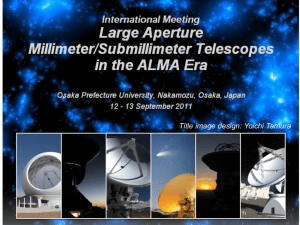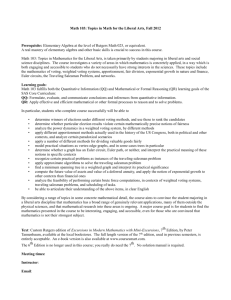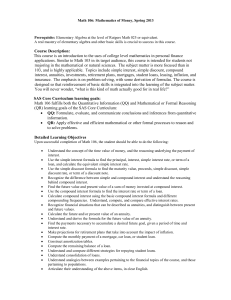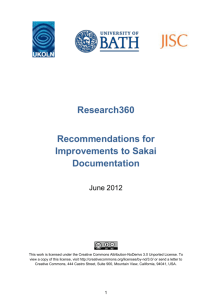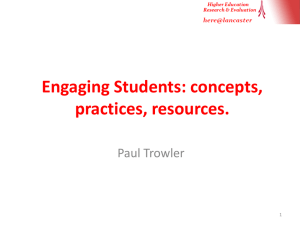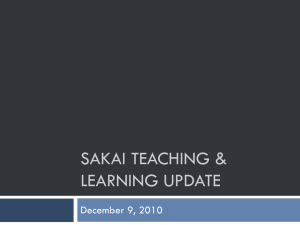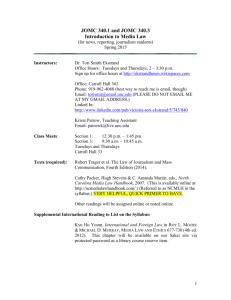742: Readings in Media History
advertisement
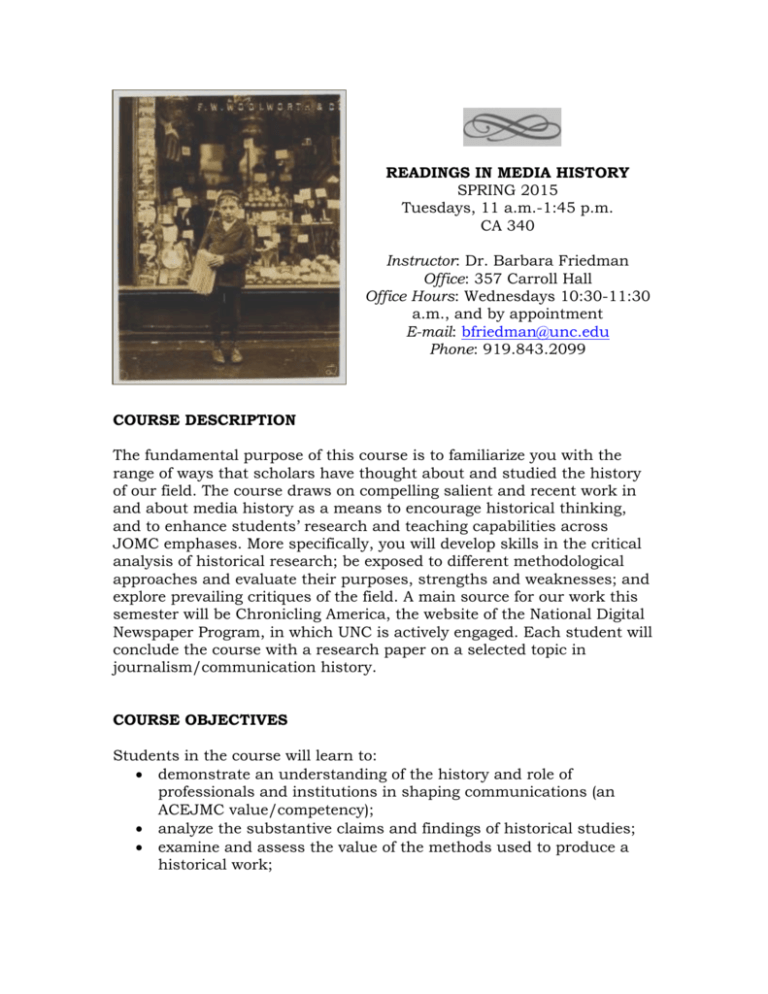
READINGS IN MEDIA HISTORY SPRING 2015 Tuesdays, 11 a.m.-1:45 p.m. CA 340 Instructor: Dr. Barbara Friedman Office: 357 Carroll Hall Office Hours: Wednesdays 10:30-11:30 a.m., and by appointment E-mail: bfriedman@unc.edu Phone: 919.843.2099 COURSE DESCRIPTION The fundamental purpose of this course is to familiarize you with the range of ways that scholars have thought about and studied the history of our field. The course draws on compelling salient and recent work in and about media history as a means to encourage historical thinking, and to enhance students’ research and teaching capabilities across JOMC emphases. More specifically, you will develop skills in the critical analysis of historical research; be exposed to different methodological approaches and evaluate their purposes, strengths and weaknesses; and explore prevailing critiques of the field. A main source for our work this semester will be Chronicling America, the website of the National Digital Newspaper Program, in which UNC is actively engaged. Each student will conclude the course with a research paper on a selected topic in journalism/communication history. COURSE OBJECTIVES Students in the course will learn to: demonstrate an understanding of the history and role of professionals and institutions in shaping communications (an ACEJMC value/competency); analyze the substantive claims and findings of historical studies; examine and assess the value of the methods used to produce a historical work; 2 J742/SP 15/FRIEDMAN examine and assess the shortcomings of the evidentiary and theoretical bases of such works; recognize the diversity of approaches to historical research; understand how the discipline of journalism/mass communication developed historically and how the study of our field’s history fits within broader disciplinary conversations; recognize and understand some of the main issues/concerns in the field; think historically; that is, to think in terms of change and continuity over time while understanding the time-conditioned beliefs, practices and relationships that shape human experience; make contributions to the historical knowledge in our field by conducting original research that uses primary and secondary sources in a substantive and sound manner. REQUIRED READING Article-length readings are available on our course Sakai site. The following texts are required and to be read as directed on the syllabus. John Tosh, The Pursuit of History, 5th edition (New York: Routledge, 2013). Barbie Zelizer, ed., Explorations in Communication and History (New York: Routledge, 2008). Andie Tucher, Froth & Scum: Truth, Beauty, Goodness, and Murder in America’s First Mass Medium (Chapel Hill: University of North Carolina Press, 1994). Recommended: The Chicago Manual of Style, 16th ed. (Chicago: University of Chicago Press, 2010). You are required to have read all of the week’s assigned material before arriving to class – this will give us a common frame of reference for discussion, as it will be specifically related to the week’s themes or issues. So that your participation will be productive and substantive, you should bring your reading to class with you. Coursework and Important Deadlines Assignment Online commentary Research paper topic NC newspaper essay Research paper proposal Research paper Due date Weekly Feb. 3 Feb. 10 March 3 April 24 % of final grade 15 N/A 15 20 50 J742/SP 15/FRIEDMAN 3 Online commentary: While each student must complete all of the assigned readings each week, you must also post comments about one of the readings to our Sakai site each week. Before you come to class Tuesday, you must have read your classmates’ comments and be prepared to engage with their ideas/observations. Each week I will assign you a particular reading and role -- either questioner or responder. The questioner will post a commentary and discussion question for the assigned reading no later than Friday at 4 p.m. Responders will post commentary no later than Monday at 5 p.m. These comments should highlight important ideas, issues, or approaches raised in or by the reading. Tell us what you found compelling/engaging/problematic/perplexing in the reading, paying some attention to the focus of our course (historical methods in media history). No need to consult with others before you comment; a degree of overlap is unavoidable and expected. The questioner will then help to facilitate the in-class discussion for that class period. Important: Keep in mind that while a description of the reading can be useful when done concisely, your aim should be evaluation and analysis. NC newspaper essay: Using primary and secondary sources, each student will be responsible for writing “title scope notes” for one North Carolina newspaper earmarked for the National Digital Newspaper Program (Chronicling America). NDNP guidelines and essay examples (250- to 500-words maximum) will be provided in class and via Sakai. Research paper topic: Each student should provide a ½- to 2-page statement indicating the research topic, justification, tentative research question(s) and potential primary and secondary sources. Your project should make use of the holdings in Chronicling America, which span 1836-1922. This assignment is a draft and will not be graded; however, it is an important step toward your final paper. Research paper proposal: Your 5- to 7-page research proposal should include a clear statement of your topic and purpose; a persuasive justification of the study’s significance and originality, a background/literature review that places your topic in historical perspective and situates it among the existing relevant literature; a method section identifying the kind of history you’re writing (cultural, social, political, intellectual, etc.) and your approach; and a description of the primary sources you will investigate. All citations must conform to Chicago Manual of Style, 16th ed., available in UNC libraries and via online subscription. J742/SP 15/FRIEDMAN 4 Research paper: The course will culminate in the research and writing of a scholarly manuscript on the topic of your choosing (with instructor approval) in the field of media history (approximately 5,000 words excluding notes). The majority of your primary sources should be drawn from Chronicling America holdings. You should write toward presentation at an academic conference and publication in a scholarly journal. Your manuscript should contribute something original and meaningful to collective knowledge about media history. For best results, begin work immediately on your paper and work consistently throughout the semester. As a reminder, citations must conform to Chicago Manual of Style, 16th ed. – no exceptions. Note: Papers will be evaluated according to standards established by national conventions at which history papers are presented and, to a degree, scholarly journals in which historical research is published. These standards include: 1) originality and importance of the topic; 2) conceptualization and familiarity/engagement with relevant secondary literature; 3) clarity of research purpose and focus; 4) research methods and use of original, primary sources; 5) evidence supports the manuscript’s stated purpose, focus and conclusions; 6) quality of writing, organization and presentation; and 7) degree to which this work contributes to the understanding of media history. We will apply these standards as we read through various articles during the semester, so that you will become accustomed to the conventions of historical research. I strongly encourage you to submit your paper to one of the following conferences: American Journalism Historians Association or AJHA (May deadline); the AEJMC history division (April deadline); ICA Communication History Interest Group (November deadline); AEJMC Southeast Colloquium (December deadline); Organization of American Historians (January deadline); International History of Public Relations Conference or IHPRC (December deadline); Joint Journalism Historians Conference (January deadline). Do keep in mind that submitting your paper is a promise to attend if it is accepted. Submission to an academic conference is not a requirement of the source, but if you are planning a career in academia, demonstrating your ability to historicize our field via paper submission will hold you in good stead with potential employers. J742/SP 15/FRIEDMAN 5 Grading Policy The course will operate on several levels, and as with most graduate-level courses, its success will depend greatly on your engagement with the material. Unless otherwise indicated, written work is due at the beginning of class. Barring extreme circumstances, I do not accept late papers. Per UNC policy for graduate courses, your final grade will be expressed as an H (high pass), P (pass), L (low pass), or F (fail). Attendance Policy Students are expected to attend all sessions of JOMC 742, and excessive tardiness will certainly not endear you to the instructor. UNC policy states, “Regular class attendance is a student obligation, and a student is responsible for all the work, including tests and written work, of all class meetings. No right or privilege exists that permits a student to be absent from any class meetings except for [compelling academic conflict] or religious observance. Attendance and participation is a consideration for your final grade. Important Notes About This Course Disability Accommodations. Students in this course seeking accommodations to disabilities must first consult with the Office of Accessibility Resources & Service and follow the instructions of that office for obtaining accommodations. For more information, contact 919.962.8300 or accessibility@unc.edu. Safe@UNC. The University’s Policy on Prohibited Discrimination, Harassment and Other Misconduct states that violence and harassment based on sex and gender are Civil Rights offenses subject by federal law to the same kinds of accountability and the same kinds of support applied to offenses against other protected categories. If you or someone you know has been harassed or assaulted, you can find the appropriate resources here. J742/SP 15/FRIEDMAN 6 UNC Honor Code. “Graduate students are responsible for conducting themselves in conformity with the moral and legal restraints found in any law-abiding community. They are, moreover, subject to the regulations of the Honor Code. In brief, the Honor Code states that all students shall ‘refrain from lying, cheating, or stealing,’ but the Honor Code imparts much more. It is the guiding force behind the responsible exercise of freedom, the foundation of student self-governance at UNCChapel Hill. By abiding by the Honor Code, students can be assured that their individual rights and academic work will be respected.” For more, see http://www.unc.edu/gradrecord/front/univregulations.html#honor. JOMC 742 TENTATIVE WEEKLY SCHEDULE Week 1/Jan. 13 The Place of History in Media & Journalism David Paul Nord, “The Practice of Historical Research,” in Mass Communication Research and Theory, ed. Guido Stempel III, David Weaver, and G. Cleveland Wilhoit (Boston: Allyn & Bacon, 20013): 362-385, Sakai; Kevin Mumford, "The Ferguson Crisis in Historical Perspective," American Historian, November 2014, 20-22, Sakai; John Tosh, The Pursuit of History, 5th ed., chapters 1-3, pp. 1-87; Barbie Zelizer, “Introduction: When Disciplines Engage,” in Explorations, 1-12. John Durham Peters, “History as a Communication Problem,” in Explorations, 19-34. 7 J742/SP 15/FRIEDMAN Week 2/Jan. 20 The Past as Readable Artifact Tosh, The Pursuit of History, 5th ed., chapters 4-5, pp. 88-146; David Greenberg, “Do Historians Watch Enough TV? Broadcast News as a Primary Source,” in Doing Recent History, ed. Claire Bond Potter and Renee C. Romano (Athens: University of Georgia Press, 2012), pp. 185-200, Sakai. Frank E. Fee Jr., “Breaking Bread, Not Bones: Printers’ Festivals in Antebellum America,” American Journalism 30, no. 3 (2013): 308335, Sakai. Alan Trachtenberg, “Albums of War,” in Reading American Photographs: Images as History, Mathew Brady to Walker Evans (New York: Hill & Wang, 1989), pp. 71-118, Sakai. Week 3/Jan. 27 Working in the Archives Meet in Wilson Library (room TBA) for presentation by John Blythe, Special Projects and Outreach Coordinator; and Barbara Ilie, NC Historic Newspapers Project Librarian. Week 4/Feb. 3 Form & Authority in the Nineteenth-Century Press * Research paper topic due today * Andie Tucher, “Prologue,” Froth & Scum, pp. 1-4. Andie Tucher, “Fighting for the Truth,” Part 1, Froth & Scum, pp. 596. Gretchen Soderlund, “Covering Urban Vice: The New York Times, ‘White Slavery,’ and the Construction of Journalistic Knowledge,” Critical Studies in Media Communication 19, no. 4 (2002), pp. 438460, Sakai. Kathy Roberts Forde & Katherine A. Foss, “‘The Facts—the Color! —the Facts’: The Idea of a Report in American Print Culture, 18851910,” Book History 15, (2012): 123-151, Sakai. Week 5/Feb. 10 Some Predilections of the Nineteenth-Century Press J742/SP 15/FRIEDMAN 8 * NC title scope notes due today * Patricia Cline Cohen, Timothy J. Gilfoyle, & Helen Lefkowitz Horowitz, “Sexual Politics,” in The Flash Press: Sporting Male Weeklies in 1840s New York (Chicago: University of Chicago Press, 2008), 55-76 and excerpts, Sakai. Andie Tucher, “From Humbug to Authority,” Part 2, Froth & Scum, pp. 97-209. David Dowling, “Davis Inc.: The Business of Asylum Reform in the Periodical Press,” American Periodicals 20, no. 1 (2010): 23-45. Lucy Shelton Caswell, “Drawing Swords: War in American Editorial Cartoons,” American Journalism 21, no. 2 (2004): 13-45, Sakai. Week 6/Feb. 17 Concepts & Theories in JMC History Tosh, The Pursuit of History, chaps. 7-8, pp. 175-245. Tim Vos, et al., “Theorizing in Time: A Special Section,” American Journalism 30, no. 1 (2013): 3-43, Sakai. Kathy Roberts Forde, “What We Talk About When We Talk About Theory,” Clio, Autumn 2013, p. 1, 3-4, Sakai. Week 7/Feb. 24 Nineteenth-Century News Workers Ted Curtis Smythe, “The Reporter, 1880-1900: Working Conditions and Their Influence on the News,” Journalism History 7, no. 1 (1980): 1-10, Sakai. Agnes Hooper Gottlieb, “Networking in the Nineteenth Century: Founding of the Woman’s Press Club of New York City,” Journalism History 21, no. 4 (1995): 156-163, Sakai. Jon Bekken, “Newsboys: The Exploitation of ‘Little Merchants’ by the Newspaper Industry,” in Newsworkers: Toward a History of the Rank and File, ed. Hanno Hardt & Bonnie Brennen (Minneapolis: University of Minnesota Press, 1995), 190-226, Sakai. Week 8/March 3 ‘Outsiders’ in the Nineteenth-Century Press * Research Paper Proposal Due Today * P. Joy Rouse, “‘We Can Never Remain Silent’: The Public Discourse of the Nineteenth-Century African-American Press,” in Popular Literacy: Studies in Cultural Practices and Poetics, ed. John Trimbur (Pittsburgh: University of Pennsylvania Press, 2001), 128142, Sakai. 9 J742/SP 15/FRIEDMAN Hanno Hardt, “The Foreign-Language Press in American Press History,” Journal of Communication 39, no. 2 (1989): 114-131, Sakai. SPRING BREAK Starts 5 p.m. Friday, March 6; Classes resume 8 a.m. Monday, March 16 Week 9/March 17 The Historical Audience Susan Douglas, “Does Textual Analysis Tell Us Anything About Past Audiences?,” in Explorations, pp. 66-76. Richard Butsch, “The Citizen Audience,” in Explorations, pp. 7789. Elizabeth Bird, “Seeking the Historical Audience: Interdisciplinary Lessons in the Recovery of Media Practices,” in Explorations, pp. 90-106. David Paul Nord, “Working-Class Readers: Family, Community, and Reading in Late Nineteenth-Century America,” in Communities of Journalism: A History of American Newspapers and Their Readers (Urbana: University of Illinois Press, 2001), 225-245, Sakai. Week 10/March 24 Technology & Commercialization John Nerone, “Newswork, Technology, and the Cultural Form, 1837-1920,” in Explorations, pp. 136-156. Kevin G. Barnhurst and John Nerone, “Civic Picturing vs. Realist Photojournalism: The Regime of Illustrated News, 1856-1901,” Design Issues 16, no. 1 (2000): 56-79, Sakai. J742/SP 15/FRIEDMAN 10 Douglas Craig, “Radio, Modern Communication Media, and the Technological Sublime,” The Radio Journal-International Studies in Broadcast and Audio Media 6, nos. 2-3 (2008): 129-143, Sakai. Week 11/March 31 Commercialization & Industrialization Richard K. Popp, “Information, Industrialization, and the Business of Press Clippings, 1880-1925, Journal of American History 101, no. 2 (September 2014): 427-453, Sakai. Gerald J. Baldasty, “The Business of News,” in The Commercialization of News in the Nineteenth Century (Madison: University of Wisconsin Press, 1992), 81-112, Sakai. Week 12/April 7 The Rise of Advertising Gerald J. Baldasty, “Advertising and the Press,” in The Commercialization of News in the Nineteenth Century (Madison: University of Wisconsin Press, 1992), 59-80, Sakai. Marvin J. Olasky, “Advertising Abortion During the 1830s and 1840s: Madame Resell Builds a Business,” Journalism History 13, no. 2 (1986): 49-55, Sakai. “Madame Restell Advertisements, 1842,” in Attitudes Toward Sex in Antebellum America: A Brief History with Documents,” Helen Lefkowitz Horowitz (New York: St. Martin’s, 2006), pp. 124-125, Sakai. Ellen Gruber Garvey, “Reframing the Bicycle: Magazines and Scorching Women,” in The Adman in the Parlor: Magazines and the Gendering of Consumer Culture, 1880s to 1910s (New York: Oxford University Press, 1996), 106-134, Sakai. Week 13/April 14 Oral History & Memory Tosh, The Pursuit of History, chap. 11, pp. 303-329. David W. Blight, “‘For Something Beyond the Battlefield’: Frederick Douglass and the Struggle for the Memory of the Civil War,” Journal of American History 75, no. 4 (1989): 1156-1178, Sakai. Janice Hume, “Memory Matters: The Evolution of Scholarship in Collective Memory and Mass Communication,” Review of Communication 10, no. 3 (2010): 181-196, Sakai. Week 14/April 21 Problems & Opportunities for JMC History 11 J742/SP 15/FRIEDMAN John Nerone, “Does Journalism History Matter?,” American Journalism 28, no. 3 (2013): 7-27, Sakai. Giovanna Dell’Orto, “Why Journalism Historians Matter to Understanding International Affairs,” American Journalism 30, no. 3 (2013): 301-307, Sakai. Amy Aronson, “Everything Old is New Again: How the ‘New’ UserGenerated Women’s Magazine Takes Us Back to the Future,” American Journalism 31, no. 3 (2014): 312-328, Sakai. Andie Tucher, “The Gaffe, ‘the Stuff,’ and the Historical Imagination,” American Journalism 31, no. 4 (2014): 432-444, Sakai. Barbara Friedman, “Is That a Thing? The Twitching Document and the Talking Object,” American Journalism 31, no. 3 (2014): 307311, Sakai (NOTE: This reading will be replaced by a forthcoming series of essays on materiality in JMC history, depending on availability). FINAL PAPERS DUE FRIDAY, APRIL 24 by 4 P.M. Provide to instructor via e-mail and hard copy.

